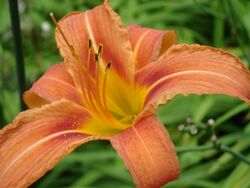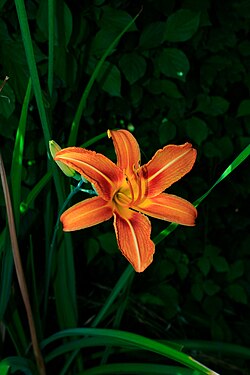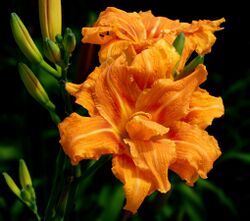Biology:Hemerocallis fulva
| Hemerocallis fulva | |
|---|---|

| |
| Flower of Hemerocallis fulva var. fulva | |
| Scientific classification | |
| Kingdom: | Plantae |
| Clade: | Tracheophytes |
| Clade: | Angiosperms |
| Clade: | Monocots |
| Order: | Asparagales |
| Family: | Asphodelaceae |
| Subfamily: | Hemerocallidoideae |
| Genus: | Hemerocallis |
| Species: | H. fulva
|
| Binomial name | |
| Hemerocallis fulva (L.) L.
| |
| Synonyms[1][2] | |
| |
Hemerocallis fulva, the orange day-lily,[3] tawny daylily, corn lily, tiger daylily, fulvous daylily, ditch lily or Fourth of July lily (also railroad daylily, roadside daylily, outhouse lily, and wash-house lily),[citation needed] is a species of daylily native to Asia. It is very widely grown as an ornamental plant in temperate climates for its showy flowers and ease of cultivation. It is not a true lily in the genus Lilium, but gets its common name from the superficial similarity of its flowers to Lilium and from the fact that each flower lasts only one day.
Description
It is an herbaceous perennial plant growing from tuberous roots, with stems 40–150 centimetres (16–59 inches) tall. The leaves are linear, 0.5–1.5 metres (1 1⁄2–5 feet) long and 1.5–3 cm (1⁄2–1 1⁄4 in) broad.[4] The flowers are 5–12 cm (2–4 3⁄4 in) across, orange-red, with a pale central line on each tepal; they are produced from early summer through late autumn on scapes of ten through twenty flowers, with the individual flowers opening successively, each one lasting only one day. Its fruit is a three-valved capsule 2–2.5 cm (3⁄4–1 in) long and 1.2–1.5 cm (1⁄2–5⁄8 in) broad which splits open at maturity and releases seeds.[5][6]
Both diploid and triploid forms occur in the wild, but most cultivated plants are triploids which rarely produce seeds and primarily reproduce vegetatively by stolons.[5] At least four botanical varieties are recognized, including the typical triploid var. fulva, the diploid, long-flowered var. angustifolia (syn.: var. longituba), the triploid var. Flore Pleno, which has petaloid stamens, and the evergreen var. aurantiaca.[5]
Distribution
Orange daylily is native to Asia from the Caucasus east through the Himalaya through China , Japan , and Korea.[5][6][7][8] Orange daylily persists where planted, making them a very good garden plant.
Hemerocallis fulva var. fulva has escaped from cultivation across much of the United States and parts of Canada and has become a weedy or invasive species.[9] It persists also where dumped and spreads more or less rapidly by vegetative increase into woods and fields and along roadsides and ditches, hence its common name ditch lily. It forms dense stands that exclude native vegetation, and is often mistaken for a native species.
Hemerocallis fulva is an invasive non-native plant in parts of the United States and is included on lists of plants to avoid planting in some states, including Maryland[10] and Virginia[11] and other mid-Atlantic states.[12]
Cultivation
Hemerocallis fulva has been cultivated in Europe and naturalized there since at least the 16th century.[13] A few cultivated varieties exist which are grown as ornamental plants.[14] Their propagation is by division since most plants in cultivation are sterile triploids.
They are long lived perennials that are adaptable to varied garden conditions and vigorous growers doing well in even difficult areas where other plants do not thrive. The plants grow well in full sun to open shade, and are drought tolerant. H. fulva is winter hardy to UDSA Zone 4.[15]
All portions of Hemerocallis species may be seriously toxic to cats and somewhat toxic to dogs. Cats are particularly vulnerable as their grooming behaviour causes them to lick accidentally transferred pollen from their fur.[16][17]
Uses
The flowers, leaves, and tubers are edible.[18][19] The leaves and shoots can be eaten raw or cooked when very young (or they become too fibrous). The flowers and young tubers can also be eaten raw or cooked. The flowers taste better when cooked but can also be fried for storage[20] or dried and used as a thickener in soup.[18] The cooked flower buds, served with butter, taste like green beans or wax beans.[21] The tubers are a good potato substitute.[4]
References
- ↑ "Hemerocallis fulv (L.) L.". Plants of the World Online. Royal Botanic Gardens, Kew. https://powo.science.kew.org/taxon/urn:lsid:ipni.org:names:536335-1.
- ↑ "Gloriosa luxurians". Royal Botanic Gardens, Kew. https://wcsp.science.kew.org/namedetail.do?name_id=307978.
- ↑ (xls) BSBI List 2007, Botanical Society of Britain and Ireland, https://bsbi.org/download/3542/, retrieved 2014-10-17
- ↑ 4.0 4.1 Elias, Thomas S.; Dykeman, Peter A. (2009). Edible Wild Plants: A North American Field Guide to Over 200 Natural Foods. New York: Sterling. pp. 136. ISBN 978-1-4027-6715-9. OCLC 244766414.
- ↑ 5.0 5.1 5.2 5.3 "Hemerocallis fulva", Flora of China, http://www.efloras.org/florataxon.aspx?flora_id=2&taxon_id=200027676
- ↑ 6.0 6.1 Huxley, A., ed. (1992). New RHS Dictionary of Gardening. Macmillan ISBN:0-333-47494-5.
- ↑ {{citation | mode = cs1 | title = Hemerocallis fulva | work = Germplasm Resources Information Network (GRIN) | url = | publisher = [[Organization:Agricultural Research ServAgricultural Research Service (ARS), United States Department of Agriculture (USDA) | access-date = 2018-01-01 }}
- ↑ S.K. Czerepanov. Vascular Plants of Russia and Adjacent States (2007)
- ↑ "USDA Plants Profile for Hemerocallis fulva (orange daylily)(Classified as invasive only by Wisconsin)". Natural Resources Conservation Service PLANTS Database. USDA. https://plants.usda.gov/core/profile?symbol=HEFU.
- ↑ "Maryland Invasive Plant List". June 22, 2023. https://mda.maryland.gov/Plants-Pests/.
- ↑ "Common Day Lily". June 22, 2023. https://mgnv.org/plants/invasive-plants/common-daylily/.
- ↑ "Common Daylily (Hemerocallis fulva)". https://www.invasive.org/alien/pubs/midatlantic/hefu.htm.
- ↑ Sir Ghillean Prance; Mark Nesbitt (12 October 2012). The Cultural History of Plants. Routledge. pp. 268–. ISBN 978-1-135-95811-4. https://books.google.com/books?id=niwsBgAAQBAJ&pg=PA268.
- ↑ John H. Wiersema; Blanca León (26 February 1999). World Economic Plants: A Standard Reference. CRC Press. pp. 256–. ISBN 978-0-8493-2119-1. https://books.google.com/books?id=gZlWfNTm-boC&pg=PA256.
- ↑ Tomasz Ani_ko (1 January 2008). When Perennials Bloom: An Almanac for Planning and Planting. Timber Press. pp. 247–. ISBN 978-0-88192-887-7. https://books.google.com/books?id=ODYpMZXFnSQC&pg=PA247.
- ↑ "Lovely Lilies and Curious Cats: A Dangerous Combination". US Food and Drug Admin. 16 September 2021. https://www.fda.gov/animal-veterinary/animal-health-literacy/lovely-lilies-and-curious-cats-dangerous-combination#:~:text=Lilies%20in%20the%20“true%20lily,the%20water%20in%20a%20vase..
- ↑ Milewski, Lynn M.; Khan, Safdar A. (2006). "An overview of potentially life-threatening poisonous plants in dogs and cats". Journal of Veterinary Emergency and Critical Care 16 (1): 25–33. doi:10.1111/j.1476-4431.2005.00151.x. https://confluence.cornell.edu/download/attachments/117750764/JVECCS%20Poisonous%20Plants.pdf. Retrieved 2022-07-28.
- ↑ 18.0 18.1 "Hemerocallis fulva". http://www.pfaf.org/user/Plant.aspx?LatinName=Hemerocallis+fulva.
- ↑ "Edible Landscaping: Eat Your Environment". 26 May 2018. https://www.homestead.org/food/edible-landscaping-eat-your-environment/.
- ↑ United States Department of the Army (2009). The Complete Guide to Edible Wild Plants. New York: Skyhorse Publishing. pp. 51. ISBN 978-1-60239-692-0. OCLC 277203364.
- ↑ Niering, William A.; Olmstead, Nancy C. (1985). The Audubon Society Field Guide to North American Wildflowers, Eastern Region. Knopf. p. 600. ISBN 0-394-50432-1.
External links
Wikidata ☰ Q1424440 entry
 |



